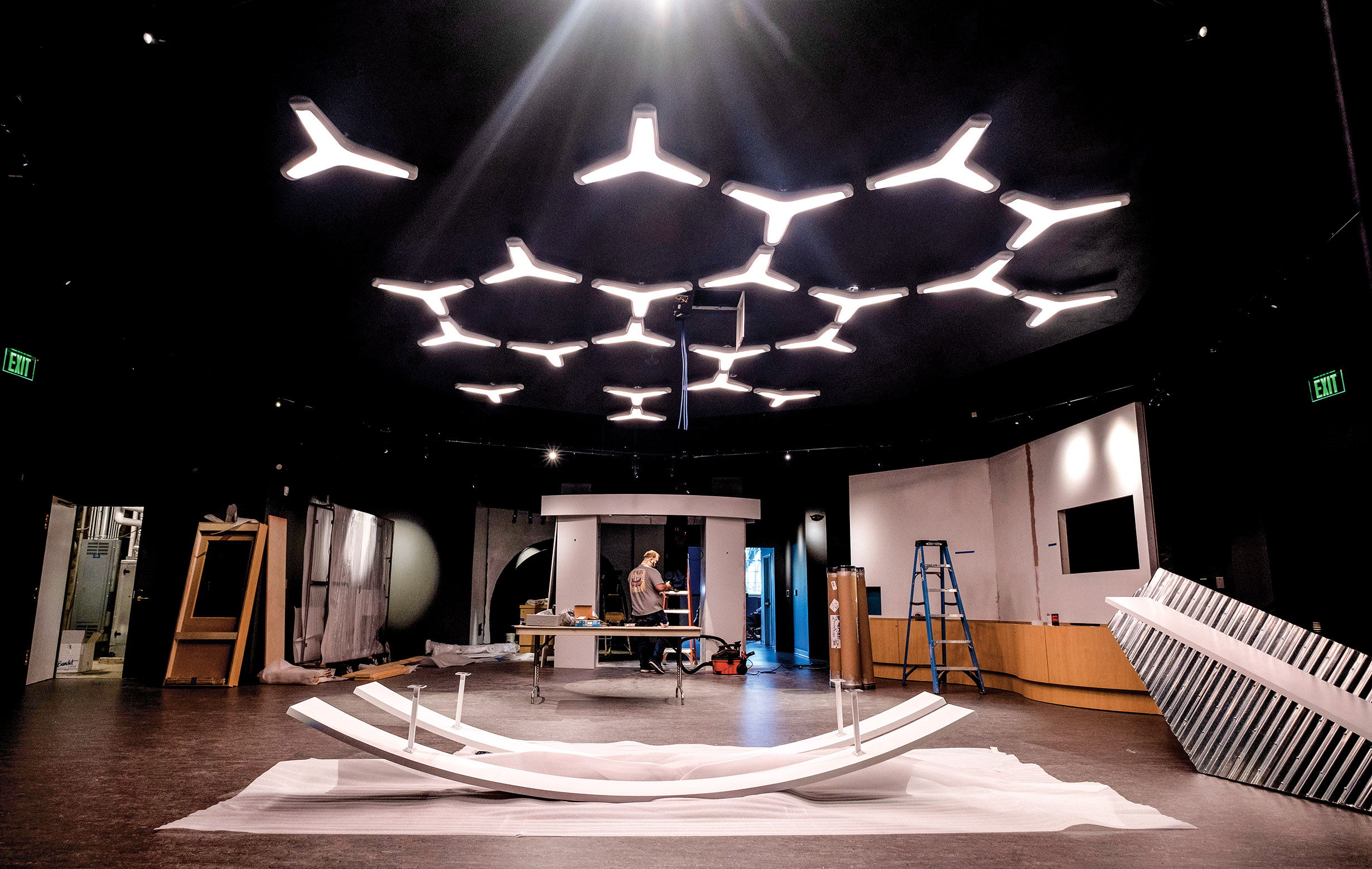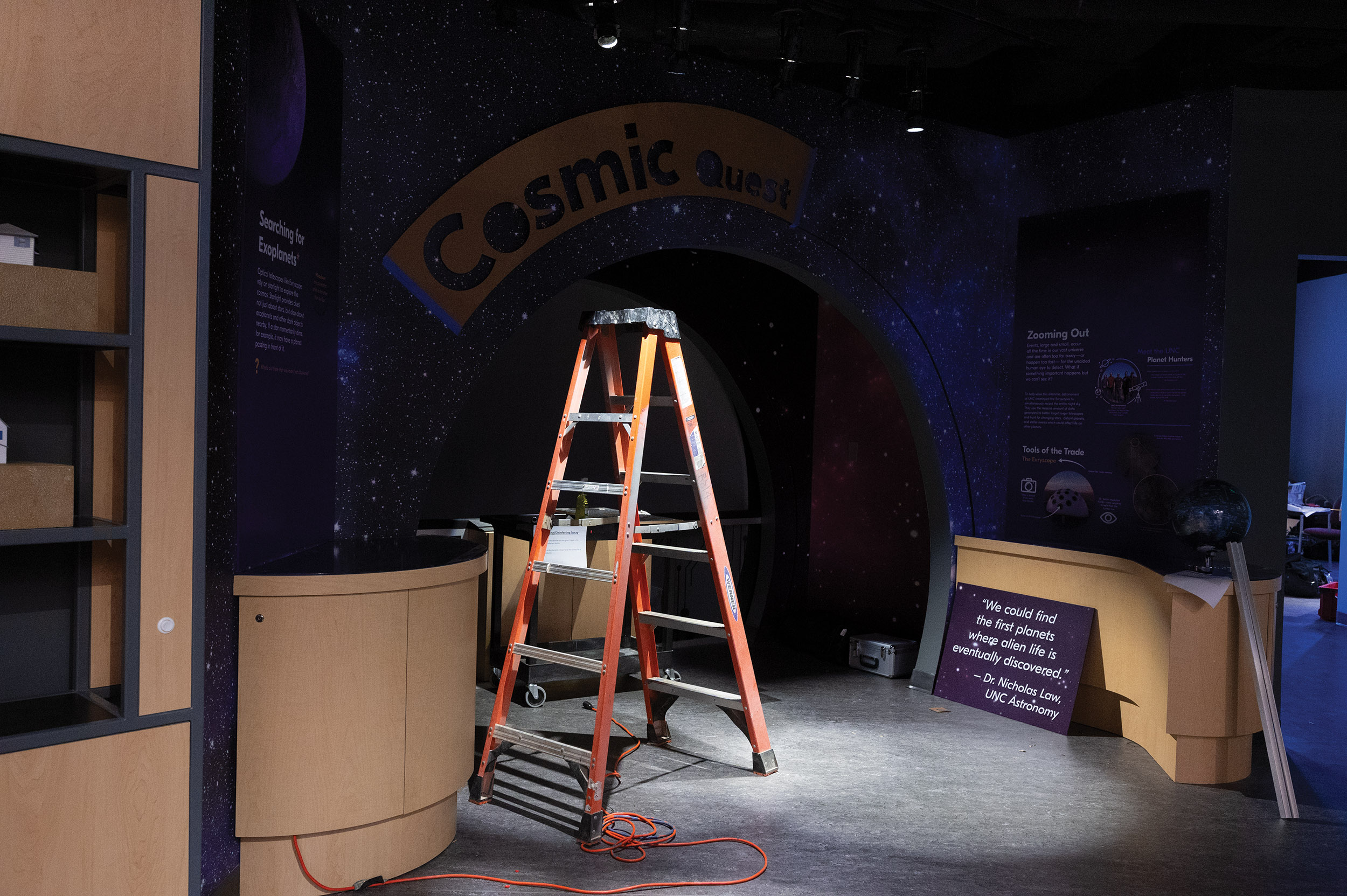Science Project
Posted on Nov. 13, 2020
(Grant Halverson ’93)
The planetarium is a 70-year-old story of awe and wonder — and of deferrals of the bigger mission to showcase the range of Carolina’s scientific research. At last, it has pushed out the horizons.
by David E. Brown ’75
“Larger than life” is a special category of praise. In Carolina’s life, the phrase evokes Frank Graham (class of 1909) in the front office, Michael Jordan ’86 and Mia Hamm ’94 on the fields of play, the civil rights lawyer Julius Chambers ’62 (LLBJD).
And John Motley Morehead (class of 1891). Scientist, entrepreneur, soldier, politician, ambassador, philanthropist extraordinaire. One of those could have been a full life. As he moved on from the Bell Tower donation to focus on his real passion — discovery — Morehead articulated his thoughts about the fruits of education. The educated man, he said (he was not, apparently, ahead of his time in gender equity), was one “who knows everything about something and something about everything. … History, philosophy, law, economics, art, music and the classics, of course — but all of the natural sciences as well.”
Morehead probably could not have chosen a more visually and sensuously impressive scientific spectacle than a planetarium. In 1949, his work led to the first one in the South, the first outside a major city and the first attached to a university anywhere in the world.
A Star Maker and His Machinery
Tony Jenzano came to Chapel Hill to install Morehead’s first star projector in 1949 and never left, becoming director and running the planetarium for more than 30 years before retiring in 1981. His contribution to the U.S. space program is told in the new book Tony Jenzano, Astronaut Trainer: The Man Who Made the Stars Shine, written by Michael G. Neece ’97.
For UNC’s astronomers and physicists it was showtime. Who can dream up publicity like the barely 10-year-old planetarium received when real-life spacemen came there to train?
But it was a one-act.
The planetarium was renamed the Morehead Planetarium and Science Center two decades ago, and the vision of this jewel at the University’s front door as a more broad-based science exhibition center is older than that. The challenge was not only money; the design Morehead oversaw packed in a massive star theater; a state dining room; an elegant salon; a rotunda to display Mrs. Morehead’s art; and, on the lower floor, a large space for a mechanical planet display ringed by a dark, narrow passageway of still-life displays, which gradually became dreary antiques.
The theater, converted to digital 10 years ago, and the dining room remain.
Where the Moreheads once showed off a “living room” with a then-astonishing $25,000 worth of furniture will soon become a science classroom. Where a towering rotunda gave a hands-off, walk-softly-and-quietly vibe will be an interactive exhibit on the planetarium’s history, including a sit-in replica of the model in which the astronauts trained. Where cutting-edge expos circa 1949 fell to dust, walls have been pushed out for a wave tank, maker space and exhibits of current UNC research in environmental science, public health, biomedical engineering — the gamut of the physical sciences.
The Morehead has introduced programming in the nonastronomy sciences for several years — notably in a series of children’s camps.

In the space that held the once-fascinating orrery, the Morehead is installing nine interactive, changeable exhibits from across the landscape of UNC’s physical science teaching and research. On previous pages, the original rotunda will be the front door to the new Morehead. (UNC/Jon Gardiner ’98)
“Now, finally, we have a facility with exhibits and other experiences that match our name and broad mission,” said Todd Boyette, who has been director since 2006, only the Morehead’s fifth, “and I look forward to sharing these experiences with the state of North Carolina. We are highlighting the unique resources of UNC — we’re able to convey the broad array of sciences that are studied and researched on campus.”
John Motley Morehead was, after all, a chemist.
Insurmountable — not
“Wish it wasn’t in the middle of a pandemic, but we persisted,” Boyette said as exhibit installation began in September. The new Morehead with its sixfold increase in exhibit space opened on Nov. 7. “This has been on my mind since I arrived. We’ve run into a lot of roadblocks, and we kept taking detours.”
The renovation has been through several iterations. Once, the Morehead Foundation that occupies the east end of the building considered swapping sides with the science folks. There was talk of underground parking and expanding the building toward Franklin Street. That plan was ambitious, but by 2009 the Morehead was high on UNC’s capital projects funding list; then the economy collapsed. Boyette realized it would be many years before such a project would be a priority again.
“The people who were saying it was insurmountable were right — it was difficult — but they underestimated the determination of a lot of these people,” said Holden Thorp ’86, the former chancellor who directed the planetarium for five years and got the camps going but labored with an ancient analog star projector long after the Morehead’s prominent peers had gone digital. “It’s a story of persistence and determination, mainly Todd.
“I had hoped we could keep people in the building for longer and we could have a way to showcase science at Carolina and beyond,” added Thorp, now editor-in-chief of the Science family of journals. “There’s a need for interpretation of science for the broader public. I felt, and I still do, the people who really know what they’re doing need to explain science for the broader public. It’s not easy. Informal science education is a highly specialized and important skill. Most scientists don’t have it, and there’s often even pressure among scientists to shun that.”
Without it, he said, you’re dependent on the mainstream media to tell your story.
In about 2012, the Morehead decided to self-fund the remake with no expectation of money from the state. It wound up getting $2.7 million in repair and renovation money from the University, and the rest of the $9.2 million project came from private gifts.
Before renovation began, the public had access to 10,000 square feet. That’s been raised to more than 16,000 without adding to the building.
Lab-to-life exhibits
“This is a wonderful storytelling room.”
Five generations agree. Boyette is in the somewhat reimagined 70-year-old star theater, underneath the eerie glow of the dome amid new seats that no longer surround the room in concentric circles. There’s a quadrant left empty; stories aren’t told just by unseen voices narrating planetarium shows but by live lecturers, poets, musicians and dancers — the heavens are their ambience. Catered dinners have a place here. The space, freed up when the old Zeiss projector departed, has created opportunities.

The maker space will show young people about, for instance, work with prosthetic hands in biomedical engineering. (Grant Halverson ’93)
Astronomy will have a prominent place in the new Morehead as the first thing encountered after visitors pass through the new main entrance on the building’s imposing west side — the side that was designed as the front door but for so many years was not for planetarium audiences. The rotunda, now absent of the paintings and the statue of 1818 graduate President James K. Polk, houses a permanent exhibit on the planetarium’s history — its founder’s vision; a star-sighting video game; and a focus on the Apollo 12 mission, whose pilots had to rely on what they learned here after they were twice struck by lightning and lost some instrumentation sensors.
“The building was not constructed to be a science center,” said Jay Heinz ’07 (MA), the Morehead’s digital production and exhibits manager. “The science center aspect of it was shoehorned into the building, and the experience for a visitor was always sort of disjointed. These corners of the building you had to search out.
“We wanted the visitor to step into the new entrance on the west side and have a continual experience that’s easy to move through and makes sense.”
Downstairs, the mechanical model of the solar system stopped revolving long ago, and the big round room became storage. It’s now the center of the nine new lab-to-life exhibits.
Visitors can activate a wave tank to learn about the ways seawalls and dunes affect rising sea levels, and vice versa. They can put an arm in a cuff and manipulate a prosthetic device on a mannequin to study biomedical engineering work in prosthetics. Hand gestures and body movements cue software that enables the Evryscope, an array of telescopes developed at Carolina that cover the entire accessible sky, to tour just the area you tell it to.
When sea turtles hatch on North Carolina beaches and start their migratory journey in the Atlantic, they’re guided by a kind of GPS that reads magnetic fields. Kids can grab a knob and move a turtle around the Earth and manipulate a magnet to understand how all that works.

“We wanted the visitor to have a continual experience that’s easy to move through and makes sense,” said Jay Heinz ’07 (MA), digital production manager. (Grant Halverson ’93)
“This is the place where the public is going to be able to get a view into the world of science at UNC that they wouldn’t be able to get normally,” Heinz said.
“There is this rich history that’s connected to UNC science and connected to NASA and the state. We’re telling the story in an experiential way of cutting-edge science that’s happening here. You can learn about these scientists who are doing this incredible research. But a kid also can put themselves in the shoes of scientists and experience what it’s actually like to be a scientist at UNC.”
The opening exhibits were designed pre-pandemic, but the renovation includes flexible space where UNC’s virus research can be addressed. “Our renovation has been totally a reinvention of our entire visitor experience,” said exhibits manager Lizz Alfano. “It has brought our building up to the 21st century.”
The UNC focus on maker spaces fits into the Morehead’s interactive programming. Where traditional labs emphasize learning about tools and takeaway products, this one is about young people grasping scientific concepts and process.
“Not to make a thing and leave with it but to manipulate things and learn about circuits, or heart valve research,” said programming director Whit McMillan. “What is a valve and how does that work within their own bodies? We want them to design something to solve problems — can you build a one-way valve? — then test what they build. You don’t want blood to flow backward in your heart.
“This is not a show. Here it is much more self-discovery, and that’s what we want to foster. As a friend of mine said, ‘You want to be the guide on the side instead of the sage on the stage.’ ”
David E. Brown ’75 is senior associate editor of the Review.
Details of the Morehead reopening, including COVID-19 safety measures: moreheadplanetarium.org.
Thanks for reading the Carolina Alumni Review
Carolina Alumni members, sign in to continue reading.
Not yet a member? Become one today.
